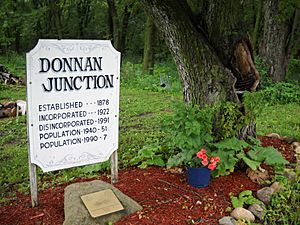List of ghost towns in Iowa facts for kids
A ghost town is a place where people used to live, work, and build a community, but now it's mostly empty or completely abandoned. Imagine a town that once buzzed with activity, but then everyone left, leaving behind empty buildings and silent streets. Iowa has many such places, and this article will tell you about some of them.

What are Ghost Towns?
A ghost town is a former settlement that has very few or no remaining inhabitants. These towns often have old buildings, roads, and sometimes even cemeteries left behind. They are like echoes of the past, telling stories of how people lived long ago.
Why Do Towns Become Ghosts?
Towns can become ghost towns for many reasons. Sometimes, the main reason people settled there disappears. For example:
- Mining Towns: If a town grew because of a mine, it might become a ghost town when all the valuable minerals are dug up.
- Railroad Changes: Many towns started along railroad lines. If the railroad moved or a new, faster route was built, the town might lose its importance.
- Natural Disasters: Floods, droughts, or other natural events can force people to leave their homes.
- New Roads: When major highways were built, they sometimes bypassed older towns, causing businesses and people to move away.
- Dams and Lakes: Some towns were intentionally flooded to create new lakes or reservoirs, like those submerged by Lake Red Rock in Iowa.
Some Ghost Towns in Iowa
Iowa has many ghost towns, each with its own story. Here are a few examples:
- Buxton: This was a unique and thriving coal mining town in Monroe County. It was known for its diverse community, where people of different backgrounds lived and worked together. When the coal mines closed, the town slowly faded away.
- Coalport, Cordova, Dunreath, Fifield, Oradell, Percy, Red Rock, and Rousseau: These towns were all located in Marion County and shared a similar fate. They were submerged by the waters of Lake Red Rock when the Red Rock Dam was built. Their old locations are now under the lake!
- Donnan: Located in Fayette County, Donnan was once a small community. Today, only a memorial sign marks its former location, reminding us of the town that once stood there.
- Mount Pisgah: This town in Union County was an important stop for pioneers traveling west. It was a place where people rested and prepared for the rest of their journey. Over time, as travel routes changed, the town became less important.
Here is a list of some other ghost towns in Iowa:
- Big Spring (Wayne County)
- Bryantsburg (Buchanan County)
- Buchanan (Cedar County)
- Buckhorn (Jackson County)
- Caledonia (Ringgold County)
- Civil Bend (Fremont County)
- Clarkson (Warren County)
- Conover (Winneshiek County)
- Doris (Buchanan County)
- Dudley (Polk County)
- Dudley (Wapello County)
- Elkport (Clayton County)
- Herring (Sac County)
- Hinkletown (Keokuk County)
- Green Island (Jackson County)
- Griffinsville (Appanoose County)
- Iowaville (Van Buren County)
- Ivanhoe (Linn County)
- Knowlton (Ringgold County)
- Lakewood (Lyon County)
- Littleport (Clayton County)
- Lucky Valley (Woodbury County)
- Midway (Johnson County)
- Motor (Clayton County)
- Queen City (Adams County)
- River Junction (Johnson County)
- Shady Grove (Buchanan County)
- Siegel (Bremer County)
- Strahan (Mills County)
- Unique (Humboldt County)
- White Pigeon (Keokuk County)
- Yatton (Washington County)
Ghost towns are a fascinating part of history. They remind us that nothing stays the same forever, and even towns can disappear over time.

